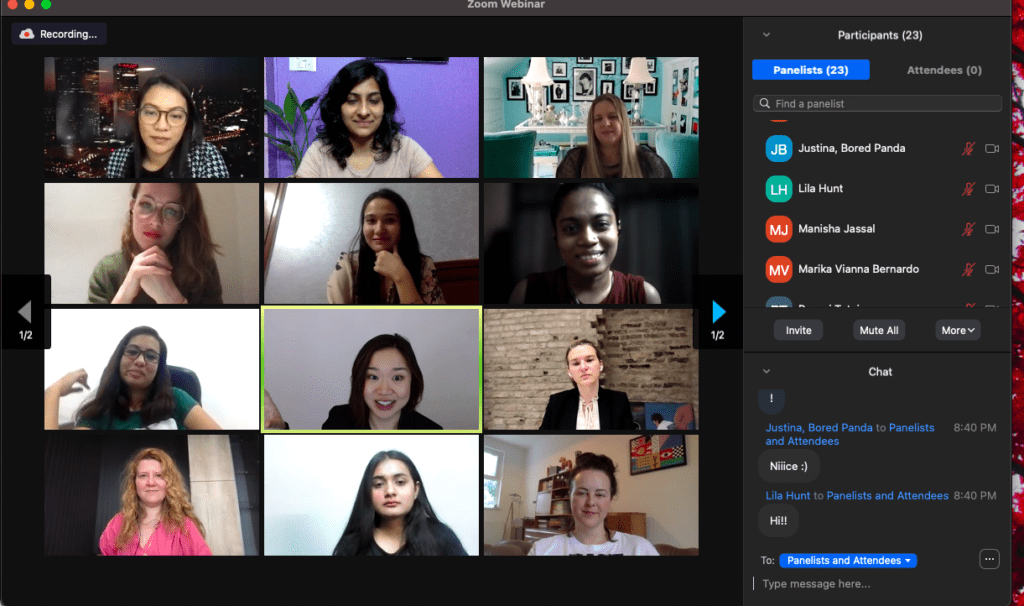“I think the programmatic technology world is moving so fast, but it’s still a bit like an old boy’s club. You’ve got to know who in the right organization monopolies to get a seat on exchanges,” says Cathy Ma, one of the attendees of AdPushup’s first-ever women-only meetup.
Cathy, here, refers to the male-dominated programmatic industry and how it is yet to provide a ‘level-playing field’ for women working in the ad tech space.
Having quoted that, we wish to celebrate women in adtech rather than complaining about the odd gender ratio.
Introducing Women Leaders of Ad Tech:

Before we get into the discussions, here are the women who shared their experiences, thoughts, challenges, and triumphs with us:
- Sophie Toth, Programmatic and ad tech lead Euronews
- Emily Roberts, Programmatic Sales, EMEA at BBC
- Justina Palinaviciute, Head of Ad-Ops and Monetization at BoredPanda
- Cathy Ma, Consultant at Beijing Tailun Shuguang Consulting Co., Ltd.
- Emily Palmer, Digital Marketing & Media Consultant
- Ester Yonatan, Strategic Partnerships Lead at StartApp
- Ekin Koseoglu, Chief Operating Officer at Interesting Engineering
- Lila H., Head of Digital Ad Strategy at System1
- Jan Arnaiz, Head, Programmatic Growth & Revenue at Rappler
- Marika Vianna Bernardo, Partnerships Lead for Programmatic at Summit Media
Each of these women has made notable contributions to the ad tech space, and all of us at AdPushup are proud to call them our friends and partners.
Questions We Asked:
- What are the biggest challenges publishers or ad tech professionals face while improving their site’s ad revenue?
- What are a few technical tools you swear by?
- For content and user experience, there are usually priorities, but revenue is essential too. So, what kind of a model can ensure a balance between the two?
- What is your advice to niche publishers who see the impact of Low revenue due to the pandemic?
- What are a few challenges that you’ve faced concerning SEO?
- What are the biggest challenges publishers or ad tech professionals face while improving their site’s ad revenue?
We’ll go through each of these and share key takeaways from the discussion. Let the scrolling begin:
Q1. What are the biggest challenges related to revenue strategy?
Implementing a revenue strategy brings a unique set of challenges. If you don’t have an expansive skill set, executing a successful revenue-generation strategy will be difficult.
We addressed both these questions to Sophie Turner from Euronews, and Emily Robers from BBC, who shared interesting perspectives:
Sophie: “I think for publishers, programmatic as a whole is a challenge. As one of the columnists said, it’s a continuously changing environment. People who work in this field need to be dedicated; it requires attention from junior to senior management levels. In addition, there are many challenges around data, strategy, finding new ways of revenue, and budget for innovation.”
Emily: “I think in terms of customers, there is still a lack of information for customers to really understand how publishers monetize their website. Digital readers just don’t understand how publishers make money.”
Learn more:
- How AdPushup helped AdSense Publishers Increase their Ad Revenue
- AdPushup Guarantees a 20% Revenue Uplift
Q2. What tools do you swear by?
We asked Sophie about the technical tools she relies on, and here’s the list of tools and trends she uses at Euronews:
- Reporting tools: The reporting tools help her organization build customer satisfaction based on data-driven reports, increasing productivity by optimizing services, and monitor data in real-time.
- Tech vendors: Sophie and her team rely on ad tech vendors who have seen their organization’s data and viewability journey and understand how they serve personalized ads for monetization.
- Weekly reports: Weekly reports help teams maintain a higher level of visibility into initiatives and campaigns.
- Google Ad Manager: Home section to instantly see programmatic or non-programmatic abilities and get extensive reports.
Q3. How to balance ad revenue and user experience?
With the rapid proliferation of mobile devices, UX is much more than ‘making content look good.’
A good user experience means good business. Interestingly, during the inception of Amazon, Jeff Bezos invested 100x more in UX than in advertising.
We asked Emily Roberts about her thoughts, and she talked about maintaining the balance between the number of ads placed on each web page.
“A lot of publishers are not prioritizing customers. Instead, they are targeting them with a billion ads on each page. At the BBC, we’ve quality over quantity. We’ve 3-4 ads per page, and we don’t bombard ads on the user’s face. But for us, fewer ads also means that CPM and cost of each ad are higher, which helps us earn more revenue, alongside ensuring better UX.”
Emily Roberts, BBC
Emily says publishers should offer high-quality ads and a good ad experience that boosts revenues and delights users.
In her words, it’s better to place fewer numbers of quality ads (and sell them at higher prices) than cramming the page with poor quality ads (sold at lower prices).
Learn more: Publisher Business Models: 9 Lucrative Models to Experiment With
Q4. How to look at ad revenue during a global pandemic?
The ongoing coronavirus pandemic is impacting digital publishers, and ad tech professional’s as well. The COVID-19 pandemic has caused a significant drop in advertising spending.
In fact, ad spends are down 9% across Europe, and 12% to &% in France and Germany.
What really helped our women experts get through it was building a solid network and relations with advertisers and other top players in the industry.
“It’s all about maintaining relationships with advertisers at the end of the day and targeting trending topics. We did big PR pieces, especially around the pandemic and topics like black lives matter. Some advertisers were blocking that particular piece of content, for example, articles on black lives matter. But, the amazing impact was being made because of the trending movements and positive stories around the pandemic.”
In other words, publishers can survive the pandemic’s impact by making special efforts to maintain a cordial relationship with advertisers. The give-and-take approach and meaningful two-way communication work better as it helps maintain relations over a longer period.
Learn more: How to Minimize the Impact of COVID-19 on Ad Revenue
Q5. How to keep up with ad revenue goals?
We asked both Emily and Sophie about the key strategy that can help publishers keep up with their revenue goals, and here’s the highlight:
- Innovation: Publishers need to be innovative, especially with programmatic. They should try newer technology and focus on appropriate vetting processes.
- Networking: It’s also important to exchange ideas and build networks. As a publisher, you need to ask around, share ideas, learn from experts and big publishers in programmatic.
- Active collaboration: Independent alliances can further help small publishers to grow. Apart from this, contribution in white paper studies, researches is fruitful too. Talk to each other more, spend energy on it. Because programmatic is a great technology and we’re yet to explore its potential.
- Customer’s perspective: Whether you’re deciding on the number of ads or format, make sure to prioritize your customers and what they may experience. Always think about the consumers. The end goal should be about the consumers.
Learn more:
Q6. What about the impact on page performance score?
One of the attendees questioned about slower loading speed and how it’s impacting her website’s revenue, and we got an interesting answer here as well.
Rashmita from AdPushup discussed how a large volume of unoptimized images is the most common reason behind a website’s poor loading speed.
If your website is crammed with ads and many images, your websites’ speed will suffer because they’re rendering lots of Javascript and heavy assets with each image and ad.
This will make users abandon pages, resulting in higher bounce rates and lower conversions. In fact, 53% of users will leave a website if the page takes longer than 3 seconds to load.
Here are few practical solutions for this problem:
- Optimize and reduce the size of your images
- Remove resource-hogging add ons and plugins
- Use a CDN
- Enable caching
Read more: 7 Ways to Optimize Your Website for Faster Ad Serving.
In Closing:
There you have it – expert tips and advice from women leaders in ad tech.
We learned that it’s essential to stay curious and empower others.
In programming, you can actively focus on innovation and continuously ask questions because there are many ideas and opportunities for those who want to find them.
Thank you for taking the time to read this post; we hope that you learned something you didn’t know before. We’d like to thank all the experts that contributed to this meetup. It was an absolute pleasure speaking with all of you!
Missed the Meet-up? Catch the Recording Here:

Shubham is a digital marketer with rich experience working in the advertisement technology industry. He has vast experience in the programmatic industry, driving business strategy and scaling functions including but not limited to growth and marketing, Operations, process optimization, and Sales.




![CTV vs OTT Advertising: Which one is Right Pick for Publishers? + [6 Bonus Strategies] Ott vs Ctv](png/featured-image-270x180.png)


